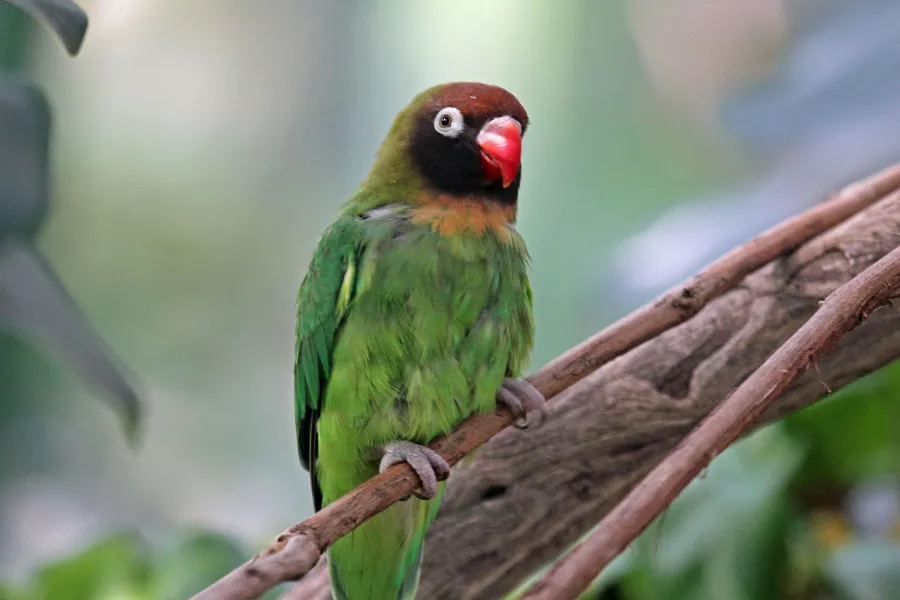What is a black cheeked lovebird?
Black-faced peony parrot (scientific name: Agapornis nigrigenis): body length 13-14 cm, weight 38-40 grams. The body of this parrot is green, with reddish-brown forehead and forehead; black-brown between the eyes and beak, cheeks, and throat; dark yellow-green behind the head and neck; orange-red above the chest, gradually reaching the lower part of the chest Turning to yellow-green; belly and inner tail coverts yellow-green, tail light green; eyes with a thick and wide white circle, red bill, brown iris.
Mainly inhabits bushes, thorny plains, and open grasslands between 600-1000 meters where acacia plants are grown; prefers activities in river valleys. The habitat area is about 2500 square kilometers. The habitat is usually very close to the water source, and usually a small group to dozens or so live together. Very noisy by nature; often gathers in large numbers in farming areas, foraging for millet, corn and cereal crops, etc.; has the habit of seasonal migration, usually nomadic bird species, and the location of activity depends entirely on the availability of food . Distributed in the southwestern African country of Zambia.
What does a black cheeked lovebird look like?
The black-faced peony parrot is 13-14 cm long and weighs 38-40 grams. The body of this parrot is green, with reddish-brown forehead and forehead; black-brown between the eyes and beak, cheeks, and throat; dark yellow-green behind the head and neck; orange-red above the chest, gradually reaching the lower part of the chest Turning to yellow-green; belly and inner tail coverts yellow-green, tail light green; eyes with a thick and wide white circle, red bill, brown iris. Juveniles are darker in colour and have a black beak.
black cheeked lovebird living habits
The habitat is usually very close to the water source, and usually a small group to dozens or so live together. In the breeding season, there will be groups of about 20-100 birds, which are very noisy by nature; they will gather in large numbers in farming areas, foraging for millet, corn and cereal crops, etc.; they have the habit of seasonal migration, usually nomadic bird species , the location of the activity depends entirely on the availability of food.
Black-faced peony parrots need to drink water at least twice a day, and the season is a key factor in determining daily activities. During the non-breeding season, this species gathers in large flocks of up to 800 individuals, peaking in the early morning and early evening when drinking and feeding. Feeds primarily on annual herbs and the seeds of herbaceous plants, including crops such as millet and sorghum, but also forages a variety of other plant foods such as leaves, nectar, pulp, invertebrates, bark, and moss, often with some Soil with high salinity.
black cheeked lovebird rearing
The breeding season of black-faced peony parrots in the wild is from November to December, and in Victoria Falls, it is September; the breeding season of black-faced peony parrots in captivity is not high, and the breeding season mostly starts in spring, which can provide 20×20×30 cm thick wooden nest boxes. It is necessary to provide the materials (such as straw, twigs, paper) required for nesting, etc., for its nesting, and it can also breed in groups, which can breed all year round. Lays 4-6 eggs at a time, often unfertilized, the incubation period is about 18-23 days, sometimes the female bird starts to hatch after the second egg is laid, and the young bird grows feathers about 1 month later and broods the chick. During this period, it is necessary to provide enough food for the parent birds to feed. If the parent birds lack sufficient minerals, they may pluck the feathers of the young birds. If minerals are deficient, parent birds will have a tendency to pluck the feathers of their young. With proper care they can breed several times a year, but for the health of the parent birds it is best not to exceed twice a year.
Reminder: For more knowledge about angora rabbit, lemur, bearded reedling, golden hamster, red eyed tree frog, please pay attention to: mtedr.com, providing you with different types of small pets and pet care.


























